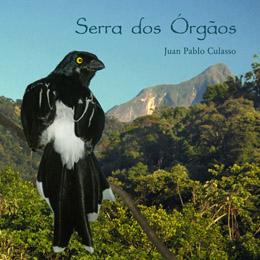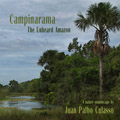

Running Time:
62 min
Release Date:
March 2013
Recording Location:
Serra dos Órgãos National Park, Brazil
If you like this album,
we also recommend:
Serra dos Orgaos
by Juan Pablo Culasso
Serra dos Órgãos (Organ Range) is a mountainous region in the state of Rio de Janeiro, Brazil.
It is a landscape rising from lowland grasslands and rainforests, to highlands with native forest, numerous freshwater springs, and all crowned by massive granitic outcrops.
This album features two recordings, made simultaneously - two dawn chorus of the same day; one of them in highland rainforest and the other in the lowlands.
The differences are many. In the highland rainforest, the landscape is introduced with the flapping of Rusty-margined Guan, together with a delicate chorus of insects. Later several species appear, the most prominent being the White-necked Thrush, along with the Red-eyed Vireo, Olivaceous Woodcreeper, Greyish Mourner and many others.
In lowland rainforest, gentle raindrops mix with a chorus of crickets and the great voice of the Black-banded Owl. Then appears the rhythmic calls of a Ferruginous Pygmy-Owl, with the forest's echoes making these voices even more interesting. Doves and Gaun join in, and eventually a couple of Rufous-capped Motmot give a wonderful climax to the album.
Juan comments:
"The Atlantic rainforest is again the star of this recording. This tropical region has given me many surprises, like the nice variety of voices over a short space of time. This recording shows the great diversity of this biome, which is so threatened by logging elsewhere.
"Hope you enjoy listening to the album as I recorded it."
Audio sample of this album
Purchase this
album as:
Digital Album
(for immediate download)
Download this album
for as little as
$7.50 -
View Special Deals
(Prices AU$, exGST)
Mp3:
Mp3 is a universal audio format, playable on iPods, computers, media players and mobile phones.
Mp3 is a compressed format, allowing smaller filesizes, offering faster download times and requiring less storage space on players, but at some expense to the audio quality. Many listeners can't really hear the difference between mp3 and full CD-quality audio, and hence its convenience has lead to it becoming the default option for audio.
Our albums are generally encoded at around 256kbps (sometimes with VBR), balancing optimal audio quality without blowing out filesizes excessively. We encode using the Fraunhoffer algorithm, which preserves more detail in the human audible range than the lame encoder.
Our mp3 files are free of any DRM (digital rights management), so you can transfer them to any of your media technology. You've paid for them, they're yours for your personal use without restriction.
Mp3 files can be burned to disc, either as an mp3 disc, or an audio CD after converting them to a standard audio (.wav or .aif) format first.
FLAC:
FLAC is a high-quality audio format, allowing CD-resolution audio. It is ideal if you wish to burn your files to a CDR, or listen over a high resolution audio system. However files usually require special decoding by the user before playing or burning to disc.
FLAC (Free Lossless Audio Codec) is a LOSSLESS compressed audio format. This means that it preserves the full audio quality of a CD, but optimises the filesize for downloading. Typically, file sizes of around 60% are achieved without any degradation or loss of audio quality from the source files at the CD standard of 16bit/44.1kHz.
Obviously the file sizes are larger than for the mp3 version - usually around 300-400Mb for an album, compared to 100Mb for an mp3 album.
In addition, you'll need to know what to do with the files once you've downloaded them. In most cases you'll want to decode the files to wav or aiff, either to import into programs like iTunes, or burn to CDR. Some programs will play flac files natively.
There is a lot of information about flac online (eg: http://flac.sourceforge.net/)




 Alternate audio link
Alternate audio link